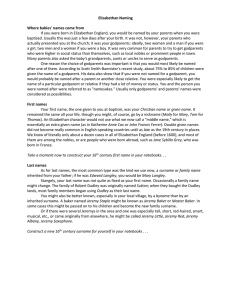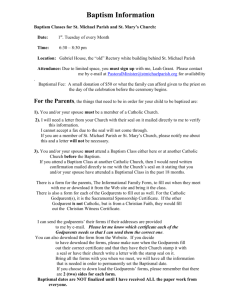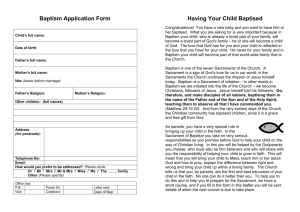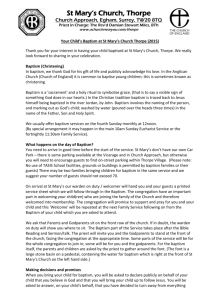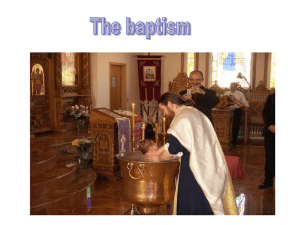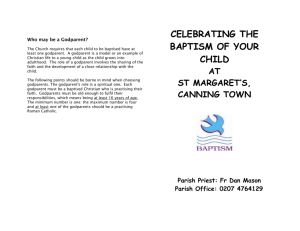XX. Family and Church
advertisement
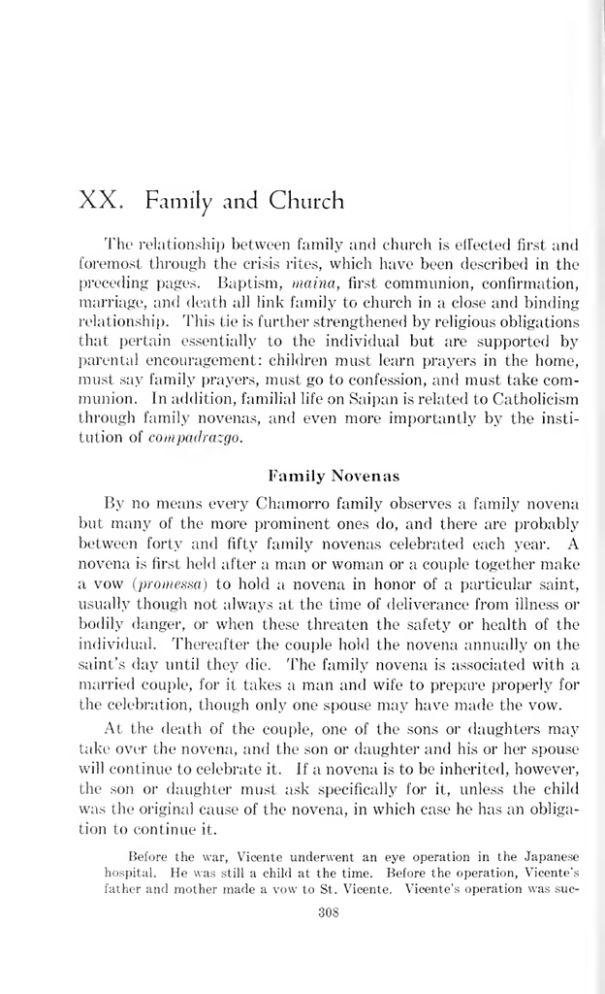
XX.
Family and Church
The relationship between family and church is effected first and
foremost through the crisis rites, which have been described in the
preceding pages. Baptism, maina, first communion, confirmation,
marriage, and death all link family to church in a close and binding
relationship. This tie is further strengthened by religious obligations
that pertain essentially to the individual but are supported by
parental encouragement: children must learn prayers in the home,
must say family prayers, must go to confession, and must take communion. In addition, familial life on Saipan is related to Catholicism
through family novenas, and even more importantly by the
tution of compadrazgo.
insti-
Family Novenas
By no means every Chamorro family observes a family novena
but many of the more prominent ones do, and there are probably
between forty and fifty family novenas celebrated each year. A
novena
a
is first
held after a
man
or
woman
or a couple together
make
vow
(pro7nessa) to hold a novena in honor of a particular saint,
usually though not always at the time of deliverance from illness or
bodily danger, or when these threaten the safety or health of the
individual.
saint's
day
Thereafter the couple hold the novena annually on the
The family novena is associated with a
until they die.
married couple, for
it
takes a
man and
the celebration, though only one spouse
wife to prepare properly for
may have made the vow.
At the death of the couple, one of the sons or daughters may
take over the novena, and the son or daughter and his or her spouse
will continue to celebrate it. If a novena is to be inherited, however,
the son or daughter must ask specifically for it, unless the child
was the original cause of the novena, in which case he has an obligation to continue it.
Before the war, Vicente underwent an eye operation in the Japanese
He was still a child at the time. Before the operation, Vicente's
hospital.
father
and mother made a vow
to St. Vicente.
308
Vicente's operation was suc-
FAMILY AND CHURCH
cessful
309
and Vicente's father and mother hold the novena every year. When
it will really be Vicente's obligation to carry on the celebration, for
they die
it
was instituted
for his benefit.
If a son or daughter does not ask to carry on the novena, it will
It is relatively common to
cease to be held after the parents die.
find novenas that have passed through two generations, but only
one instance was recorded of a family novena's passing through
three generations. In this case, an elderly woman and her husband
hold a novena that the woman took over from her mother, who in
from her own mother. Inheritance need not, howthe maternal line, as Thompson (1947, p. 192) reports
turn inherited
ever, be in
Guam.
it
the children ask for the parents' novena, the oldest
son has at least theoretical priority. Thompson also notes that,
particularly in upper class families, novenas have been celebrated
for
If all
and implies that these have been inherited in family
on Saipan is probably due to the fact
that only a few Chamorros have lived on Saipan for any appreciable
number of generations, and the nineteenth and twentieth century
immigrants to Saipan were not of the upper class, landed, Guamanian
for generations
lines.
The
different situation
aristocracy.
The following saints were recorded in connection with family novenas: San Vicente, San Isidro, San Antonio, San Jose, Correson
San Juan, San Rocce, Santa Cruz, San Ramon, Bitgen (Virgin)
Carmel, San Pedro. Undoubtedly there are others not on the
list, but these are the most popular, particularly San Vicente.
Jesus,
del
The procedure for holding a family novena is the same as that
For nine con(see Thompson, 1947, pp. 191, 317, 336).
secutive nights, friends and relatives meet in the home of the family
giving the novena. They join in a service led by a te'cha, who recites
on
Guam
the prayers, the whole group joining in the responses and in the
hymns. On the ninth evening, a large party, the guput novena, is
held, to which many more people come. This party is organized in
a fashion similar to the guput fandango, held at the time of marriage.
A mentu is appointed, women relatives as far removed as first cousins
help in the kitchen, and men and
tribute ajudo and chenchuli.
Today, Francisco held
Carmel.
worked
his
Francisco's wife and
most
women
annual
her
f/»pi//
relatives
and friends con-
novena in honor of Bitgen del
own and
Francisco's
women
relatives
day preparing the food for the party.
Francisco had slaughtered a bull for the occasion. About 5:00 P.M., guests
started to arrive. They talked quietly in small groups in the house and yard,
and smoked and drank some beer. About 6:00 p.m., the final night's services
in the kitchen
of the
SAIPAN
310
were held in the sala of the house. At the end of the room a statue of the
Virgin was set on a table. The statue was flanked by candles, and the table
and wall were decorated with paper flowers. The service was led by a man
te'cha who read or chanted the prayers from a small leaflet, written in Chamorro. These were followed by a hymn. Those present in the sala were
mostly women about thirty with some children. A half dozen men took
positions near the door. Most of the men stayed outside in the yard, drinking beer, smoking and talking about their farms, the difficult economic situation, and family matters. The service lasted a little over half an hour. Then
—
—
food was served, buffet style, the guests sitting at tables set up outside.
The menu consisted of typical party foods: a variety of meat dishes, bread
and pastry,
rice, beer, and coflfee.
Approximately one hundred people were
After the meal, the guests talked, smoked tobacco, and chewed
present.
betel for a time, then thanked their hosts, and one by one gradually departed.
It
was an informal and pleasant occasion.
The family novena party ranks with that at marriage in size
and importance, and Hke all large Chamorro guputs it is completely
bound up with family status. Certain foods, such as meat and rice,
It is an old Chamorro feeling that the vow that is
are essential.
the basis of the novena includes the slaughtering of a cow, bull, or
pig for the party. A man will feed a pig for a whole year. He
will not sell it and will save it for slaughtering at the time of his
novena. He and his wife will serve only party foods and will feel it
necessary to invite many relatives and guests. Sometimes a husband
will demur at going into debt, but usually to no avail.
On July 16, Joaquin held his annual party in connection with his novena
honor of Bitgen del Carmel. Joaquin did not want a large party, as he
has little money and gets only a modest wage by working for the administration.
But Margarita, his wife, insisted on a large party. Joaquin had to
slaughter a pig and buy two hundred pounds of rice. He spent all his money
and went into debt besides. But Margarita felt the size of the party was a
necessity, as being consonant with family tradition.
in
The
Chamorro party
an inseparable part of the pattern
and is closely linked to
the mechanisms for maintaining status. It is an essential element
of Chamorro custom. As such, it is extremely resistant to change,
even in the face of an unstable economy.
large
of interpersonal
and
is
interfamilial relations
Ritual Kinship: Compadrazgo
Every Chamorro
The
child
on Saipan has two sets of godparents.
are the godparents of baptism: the padlino bautismo and
the madlina bautismo. The second are the godparents of confirmation
first
:
the padlino conjirmacion and the madlina confirmacion.
FAMILY AND CHURCH
The godchild
311
refers to his or her godfather as "padlino"
direct address uses the
term "nino."
The godmother
is
and
in
referred to
as "madlina" and in direct address this is usually shortened to
"nina." The godparents refer to a godson as "hado," the term for
son; and to a goddaughter as "hada," the term for daughter.
also use these terms in direct address.
They
Between the parents of a child and both sets of godparents the
terms "compaire" and ''comaire" are used. In direct address these
are generally shortened to "paire" and "maire" and often are substituted for the personal names in greetings and conversation.
The terminology of ritual
kinship follows certain logical extensions.
the padlino of a child, his wife is called a madlina of the
child and a comaire of the child's parents, regardless of whether or
not she is the actual madlina bautismo or madlina confirmacion.
If
a
man
Similarly,
the child
is
if
a
woman
is
and a compaire
the madlina, her husband is a padlino of
of the child's parents, even though he is
not the actual padlino bautismo or padlino confirmacion. However,
no special obligations or functions devolve upon the "godparents by
Also, if a padlino is unmarried, after his marriage his
wife becomes a madlina; similarly, if a madlina is unmarried, after
extension."
her marriage her husband becomes a padlino. The use of these terms
again simply a logical extension of the terminology of ritual kin-
is
ship and does not necessarily involve the assumption of special
duties and obligations.
The number of godchildren of a Chamorro adult more than thirty
years of age varied from three to more than thirty in my sample.
Persons of high status in the community invariably have the most
godchildren, and few in this position have less than fifteen. The
Chamorros also exhibit a contrast with many Latin-American com-
—
munities in that godparents are very often relatives either siblings
or first cousins of the parents particularly those of the first child,
at least one of whose godparents is often a sibling of father or mother.
If the first child is a boy, the padlino frequently will be the father's
brother or first cousin, and if the godparent is married the madlina
will often be his wife.
Contrariwise, if the first child is a girl, the
—
madlina often
in
will
be the mother's sister or cousin.
which an adult did not have either
I
found no cases
siblings or cousins
among
his
or her compaire and comaire. There is no conscious attempt among
the Chamorros to exclude close relatives from the compadrazgo relationship and to select instead non-relatives.
is
true.
Rather, the reverse
SAIPAN
312
The
fact that
an uncle or aunt
is
often a child's godparent results
The choice is
in the possibility of using alternative kinship terms.
made
usually
according to the following example.
The padlino bantismo of Manuel's first child is Manuel's brother. In
Manuel does not use the compaire term instead of the brother term,
either for reference or in direct address. But Manuel's child uses the padlino
this case
term
for
Manuel's brother instead of the uncle term
{tio).
Padlino
is
a
"closer" relationship than that of a tio, and the reciprocal obligations between
a padlino and godchild are more specific than those between an uncle and a
nephew.
A
A
padlino
special case
is
is
not "closer" than a grandparent, however.
that of the child of an
unwed mother.
If
the
a boy, he will have a padlino bautismo but no madlina
hautismo, except for the logical extension of the term in the manner
child
is
previously described. If the child
bautismo but no padlino bautismo.
is
a
girl,
she will have a madlina
THE STRUCTURE OF CHAMORRO COMPADRAZGO
In the institution of compadrazgo, there are two relationships of
particular importance: that between the godparents and parents,
and that between the godparents and godchild.
trasted and compared.
These can be con-
The relationship between parents and godparents, whether of
baptism or confirmation, is one of friendliness and mutual regard.
The godparents are chosen largely on the basis of friendship when
they are siblings, as well as when they are not related, and even
when the godparent is of higher social position. The families of
higher status are not a clique and do not confine their relationships
out of working hours to their own group. Friendship is an important
component in the initial relations among compaire and comaire.
At the same
time, the relationships between godparents and
between
and
parents
godparents and godchildren are treated seriThese
ously.
relationships in no sense belong to the trivial aspects
of
Compadrazgo is a serious institution to the church
representatives on Saipan the priests and the nuns and
community
life.
—
and
its
it is
similarly considered by the people.
On
—
the other hand, just as the Chamorros have not made a point
compadrazgo to establish a wide network of relationships of
of using
a personal kind
among
non-kin, so they have not used the institution
to establish well-defined reciprocal economic obligations in production
or exchange. Nor can the compaire relationship among the Chamor-
ros be considered as a substitute for a widely extended, proliferated
FAMILY AND CHURCH
313
kinship system. In fact, specific obligations between compaire are
few and are not sharply patterned. If a man dies, his non-related
compaire and comaire need not be notified, and they will come to
his funeral only
if
they were his close friends.
They
are under no
If the compaire is related to the deceased
obligation to attend it.
and the relationship falls within the obligational range of the kinship
system, he must attend the funeral, but his attendance is an obliga-
tion of true kinship, not of compadrazgo. What specificity attaches
to the compaire relationship is primarily derived from the godparentgodchild relationship. If the godparent of a man's child dies, the
man
should assuredly go to the funeral if the child is still very young,
because surviving godchildren must always go to a godparent's
funeral. This obligation is mutual, for a surviving godparent must
attend the funeral of his godchild. If the godchild is still small, the
father goes as an adult substitute for the child, as well as a friend
of the deceased.
Likewise, at the time of marriage of a godchild,
the godmother will help the parents in the work of preparing for the
guput fandango, but this is part of her obligation to the godchild.
Among
the Saipan Chamorros
ship that
is
it is the godparent-godchild relationstrong and sharply patterned.
— those of baptism and those of
sets of
— a godson orgodparents
goddaughter observes marked respect be-
Toward both
confirmation
havior.
At
least
once a year the godchild should
call
on his two sets
Christmas or
of godparents.
The approved time
New
the godchild calls on Christmas day, he will 'ninge
Year's.
If
for this call
is
them SLfelis Pascua,
with
them.
When
the
godson is to be married,
politely
he should call on his godparents to inform them at the time or before
his parents call on the girl's parents to ask for her hand in marriage
to their son. A goddaughter may go to her madlina in similar fashion,
to his godparents, saying "hot" or "hora," wish
and converse
though her parents will notify her padlino.
Of the two kinds of godparental relationship, however, that with
the godparents of baptism is stronger and more binding. It is associated with greater obligations than is the relationship with the
godparents of confirmation. At the time of marriage, for instance,
the godson should call on his padlino hautismo before he calls on the
padlino confirmacion. The former is obligated to give nearly twice
as large a gift to the boy's family as the padlino confirmacion. The
godparents of baptism are generally those referred to when a Chamorro talks of his padlino or madlina. They assume important obligations at the time of marriage of their godchildren, whereas the
SAIPAN
314
godparents
of baptism
godparents
parents of
of confirmation play only a minor role. If the godparents
die before the marriage of the godchild, however, the
The godconfirmation can be viewed somewhat as "godparents
in reserve," to be substituted for the godparents of baptism should
of confirmation step forward to take their place.
the need arise.
As every Chamorro will say, the padlino bautismo has the obligation of being the moral advisor of his godson, and the madlina
bautismo that of her goddaughter. In the case of a respected padlino,
the godson may call on his godfather for various sorts of advice.
in cases where a man has twenty or more godchildren, he will
not take this day-to-day relation very seriously, for after all the
godchild's parents bear the first responsibility for his upbringing.
The same is true for a madlina with many godchildren. The specific
importance of the relation of godparents of baptism to their godchildren lies in the role the former play at the times of crisis rites in
the lives of the godchildren. These roles are well defined and are
the principal factors in giving the godparent-godchild relationship
Yet
its
distinctive character.
The godparents
baptism
of
baptism
of their godchild.
first of all
play principal roles at the
helps dress the child for
The godmother
may provide the christening dress. The godeach
about
$10 to the parents at the time of baptism;
give
parents
The godfather or godthis is an outright gift and not chenchuli.
the ceremony and
parents may pay the priest for performing the ceremony. Together
the godfather and godmother take the child to the church and assume
responsibility for it on this occasion, while the parents remain at
home. At the maina that takes place several weeks later, the godmother assists the mother.
At the time of first communion, the godchild calls on his godparents after the church service, pays his respects, and receives a small
gift, while the godparents attend the guput afterward at the house
of the child's parents.
•
At marriage, godparents of baptism play a very important role.
They attend the kumplimento, and the godfather of the groom presents the gifts of tobacco, betel, and the rest to the parents of the
bride and asks that the bride come into the sala. He and the godmother may sit with the nobio and nobia in the center of the room.
Next day, the godparents escort their godchildren to church and
attend them at the wedding ceremony. The godmother helps with
the work of the guput fandango. Both godfather and godmother
FAMILY AND CHURCH
have places
of
honor at the
first
serving of food.
315
They
are each
expected to give from $15 to $20 or more to their compaire and
comaire.
They receive formal calls from the newly married pair
after the festivities.
Finally, a man or woman always invites his
godparents of baptism to the marriage party of his or her own child.
At the party are present not only the godparents of the bride and
groom but the godparents of the parents as well. At marriage, it
should be added, the godparents of confirmation play no formal role,
except that they are invited to the party after the ceremony.
Death is just as important an event as marriage. If a child dies,
the godmother of baptism dresses the body, while the godfather is
Both godparents, as well as
responsible for procuring the coffin.
those of confirmation, must be notified of the death of a godchild,
the latter is young.
Regardless of the age of the
deceased, they must come to the funeral and to the lisajo afterward.
This is a reciprocal obligation. If a padlino or madlina dies, the
godchild need not be specially notified, but word of a death passes
particularly
if
quickly around the island, and when the godchild hears the news he
must drop whatever he is doing, come to the house of the deceased,
help with the
work
arrangements — a goddaughter
—and attend
the funeral services and the
of the funeral
help in preparing the food
will
lisajo afterwards.
of the obligations of godparents and godchild, this relathe emphasized one, rather than that of compaire and
It is the vertical relationship between adjacent generations,
Because
tionship
comaire.
is
not the horizontal relationship in the same generation, that
stronger and
is
the
more sharply patterned.
In this connection, it should be mentioned that the institution
compadrazgo occasionally cuts across the two ethnic groups of
Chamorros and Carolinians. The Carolinians have a kinship system
quite different from that of the Chamorros. The former is a generation type, with cousins classed as siblings and with the elementary
family less sharply marked. The Carolinians too have adopted the
of
compadrazgo institution as part of Catholicism. Among Carolinians
the compaire relationship tends to reflect their sibling relationship,
which is often important in day-to-day economic relationships.
When the compaire relationship links a Chamorro and a Carolinian,
it
may
result in a modification of the usual
following instance from field notes
is
Chamorro
pattern.
The
instructive.
Antonio has eight compuires. One of these is a Carolinian friend, not a
Several years ago Antonio built himself a house. Without being
relative.
SAIPAN
316
asked, his Carolinian compaire appeared and helped Antonio with the house.
This summer Antonio is moving to his farm and has just about completed a
new and
substantial house on his farm. By trading labor with a cousin and
a brother he got assistance for the heavy work. He never thought to ask
any of his compaire to help. But one day he met his Carolinian compaire
His compaire upbraided him in a friendly way. "Why
you let me know, Antonio, that you were building a new house? I
would have helped you." Antonio said that a Chamorro compaire, on the
basis of this relationship, would not have offered his services in this manner.
Chalan Kanoa.
in
didn't
My
own
observations confirm
this.
In a paper on ritual co-parenthood, Mintz and Wolf (1950) have
summarized important features of Latin-American compadrazgo and
offered a
number
of conclusions of
comparative importance. In
wider perspective of comparative studies, Chamorro compadrazgo
on Saipan has the following significant features:
this
(1)
Godparents are often chosen from the circle of relatives, and
no attempt has been made by the society to limit godparents to
non-kin, thereby expanding numerically the number of persons with
whom one maintains personal, kin-like relations.
On Saipan, there is no proliferation of the kinds of compad(2)
razgo, such as Gillin (1945) found at Moche, for which he describes
fourteen forms of compadrazgo. Also, the Saipan Chamorros have
not elaborated the institution so that it serves as a basis for a complex
series of reciprocal obligations in the day-to-day economic organiOn Saipan, compadrazgo is
zation of production and exchange.
primarily associated with the ritual and secular celebration of crisis
rites.
Mintz and Wolf (1950, p. 355), citing particularly the Moche
state
that "while the custom [of compadrazgo] derives primarily
case,
from a conception of spiritual parenthood, modern Latin American
(3)
emphasis seems to be rather on ritual co-parenthood; the compadrecompadre relationship outweighs the godparent-godchild relationship." On Saipan, the emphasis is the other way around. It is the
godparent-godchild relationship that is more sharply patterned and
that carries more specific obligations.
Mintz and Wolf (1950, p. 364) further conclude: "In cases
(4)
where the community is a self-contained class, or tribally homogeneous, compadrazgo is prevailingly horizontal (intra-class) in charIn cases where the community contains several inter-acting
acter.
classes,
compadrazgo will structure such relationships vertically (inThe Saipan Chamorros are homogeneous in that every
conscious of Chamorro culture as a set of traditional customs
ter-class)."
adult
is
FAMILY AND CHURCH
317
whose principal characteristics are generally agreed upon. The Saipan Chamorros are not homogeneous in that there is considerable
variation in the amount of formal education received by different
individuals, in the degree of literacy, in land-holdings, and, particularly before the war, in wealth. Social status, in the sense of being
higher or lower, is very important, but it pertains to a grading of
families, not to socially defined classes.
can hardly be said to
the differences
among
exist
among
families
A
well-defined class system
the Saipan Chamorros, granted
and individuals.
Compadrazgo
is
likewise not clearly either horizontal (intra-class) or vertical (interclass). Compaires are often of the same degree of wealth, education,
and social position, whether high or low. On the other hand, persons
of admittedly high status often have a great many godchildren,
frequently from families of lower status. The parent who selects a
godparent of higher status than himself is given the emphases in
—
—
the system opening the way for a future personal relationship be-
his child and the godparent, rather than establishing a new,
economically and socially important relationship for himself, although a compaire of higher status always adds "tone" to a baptism,
wedding, communion, or confirmation party. Thus the Saipan Chamorros do not provide a clear-cut case against which to test Mintz
and Wolf's statement.
tween
suspicion that Chamorro compadrazgo is closer to
than
to that of Latin-American communities. ReSpanish practice
the
garding
comparative significance of compadrazgo in Spain and
in the New World, Foster (1951, p. 321) notes: "In Hispanic America
this is one of the most important features of social organization,
with significant economic, religious, and emotional overtones. In
Spain, it is (and from all evidence was) of moderate importance,
invoked in the baptism and marriage of the individual, usually kept
within the family, and relegated to the category of one of a number
(5)
It is
my
of routine rites de passage."
On Saipan, compadrazgo as an institution may be more stressed
than in Spain, but there seem to be more marked similarities in
form to the Spanish practice than to that of Latin America. A
decision on the question awaits clarification of the nature of the
institution in Spain.
